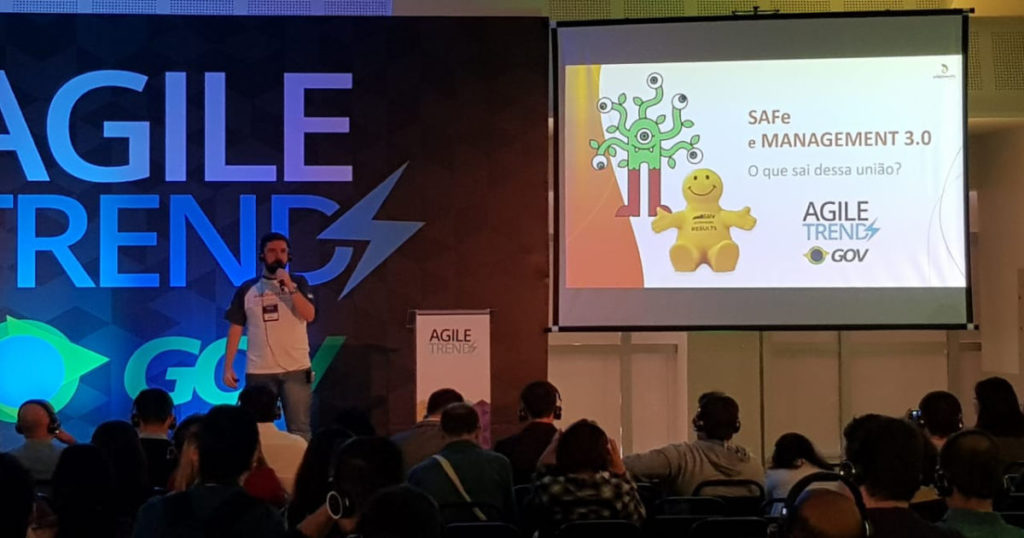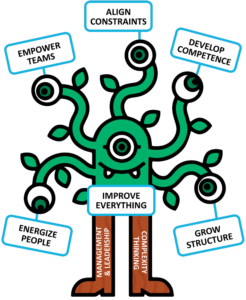By Management 3.0 Facilitator Diego Bonilha who recently attended a meetup at Adaptworks to show a powerful mix between Management 3.0 and SAFe®. In his opinion, it was one of the most interesting meetups that he had the opportunity to attend as Management 3.0 and SAFe fuelled a great debate.
Before starting our conversation, it is important to understand what Management 3.0 and SAFe are
What is Management 3.0 about?
Contrary to some people’s beliefs, Management 3.0 is not a framework or a method, but rather an agile management mindset that goes beyond IT and can be materialized through practices and tools. More and more managers, leaders, scrum masters, teams and agile coaches have been incorporating this mindset into their day-to-day life, even spreading it among different areas within the company. Recognition, empowerment and delegation, just to name a few, are already part of the culture of countless IT teams, business and human resources among others.
What is SAFe about?
On the other hand, SAFe is a scale framework that enables the organization to work with hundreds of people around a value stream, not only technology teams but also business people, executives and stakeholders, bringing transparency, purpose, vision and strategic alignment. In Brazil, SAFe has already overcome the uncertainty barrier. Each day we grow and become a promising alternative for large corporations to achieve results through agility.

Given the differences between the two, let’s explore both strategies starting with Management 3.0. The company embodies the following values as its core:
#1: Energize People
People are the most important part of the organization and management should look after them with great care and attention.
#2: Empower Teams
Empowered teams are more responsible and collaborative. This vision discusses the autonomy, delegation and empowerment of teams.
#3: Align Constraints
Self-organization can take us anywhere. You have to consider the best way to do it.
#4: Development Competence
The teams need to be able to achieve the goals.
#5: Grow Structure
The teams act in a context of complexity and, therefore, the manner that teams and organizations grow should be closely watched.
#6: Improve Everything
Jurgen Appelo, founder of Management 3.0, supports the idea of continuous improvement and constant experimentation.
The 9 Principles of SAFe
Principle #1: Take an economic view
It’s critical that day-to-day decisions are made in an appropriate economic way.
Principle #2: Apply systems thinking
A system has many interrelated components such as people and processes. SAFe reveals that optimizing one component doesn’t optimize the whole.
Principle #3: Assume variability preserve options
Instead of choosing a single design option and requirement at the beginning of the process, SAFe encourages us to keep several options for a longer period during the development cycle, thus creating better economic results.
Principle #4: Building incrementally with fast, integrated learning cycles
Develop solutions incrementally in a series of short integrated iterations, allowing for rapid customer feedback and risk mitigation.
Principe #5: Base milestones on objective evaluation of working systems
In Lean-Agile development, the integration points provide objective milestones for evaluating the solutions, replacing the phase-gates of the traditional model.
Principle #6: Visualize and limit WIP, reduce batch sizes, and manage queue lengths
Companies should strive to achieve a state of continuous flow, where new ideas move rapidly from concept to production.
Principle #7: Apply cadence, synchronize with cross-domain planning
The cadence creates predictability and provides a rhythm for the development. Synchronization causes multiple perspectives to be understood, resolved, and integrated at the same time.
Principle #8: Unlock the intrinsic motivation of knowledge workers
Providing autonomy and purpose and minimizing constraints leads to higher levels of employee engagement, delivering better results for customers and the company.
Principle #9: Decentralize decision-making
Agility requires fast, decentralized decision-making processes to reduce delays, improve product development flow and enable faster feedback.
The Connection between Management 3.0 and SAFe
Now that we’ve defined both SAFe and Management 3.0, what does this mean in the practical sense? What are the similarities and how do they intertwine?
Let’s discuss using Martie’s views:

#1 Energize People Joins with several SAFe principles
This view talks about the difference between extrinsic and intrinsic motivation, something that science has been studying for a long time. In addition to understanding that there is another motivation model that goes beyond financial rewards, you need to work on some factors, including creativity and diversity.
SAFe Principle #8 Unlock the intrinsic motivation of knowledge work
What do you think about working with 80, 100 people, or more, with different profiles, knowledge and experiences, but who are all on the same page working towards a single goal?
SAFe Principle #7 Apply cadence, synchronize with cross-domain planning
For example PI Planning, SAFe’s greatest ceremony, brings together technicians, business people, architects and executives to align and plan next week’s goals. SAFe provides moments like this as well as others in order to foster engagement among people.
SAFe Principle #5 Base milestones on objective evaluation of working systems
I also like to think that SAFe System Demo helps to energize teams. Checking your work reflected in a constantly evolving product with other teams and with feedback from business people enhances people’s engagement.
#2: Empower Teams Joins with SAFe Principle #9 Decentralize decision-making
In SAFe, teams are encouraged to make decisions, as in PI Planning, where they are empowered to assume their own goals. The confidence vote is another memorable moment of empowerment, in which all participants are invited to vote from 1 to 5 on how confident they are in achieving the business goals established during the meeting.
#3 Align Constraints Joins with SAFe Principles
If self-organization can take us anywhere, restrictions must be created so that there’s no chaos. This theme is also important within SAFe:
- Take an economic view
- Apply systems thinking
- Assume variability, preserve options
All of these factors work together to empower teams, but within the goals established by the organization and the goals of IP. At Management 3.0 we say that we can’t determine an organization’s culture and SAFe agrees that cultural change comes last.
#4 Develop Competence Joins with SAFe Principles
A Management 3.0 manager is concerned with improving the skills of his team. He must look at several dimensions such as people, quality, process, value all in order to help develop competence within the team.
SAFe brings metrics at varying levels and because it’s possible to collect metrics from teams using Scrum and Kanban, this creates opportunities for managers to act as servant leaders in order to promote the evolution of teams. It also provides the opportunity to reflect at key milestones. For example, retrospectives and Inspect & Adapt events are a must if companies want to improve this.
The latest iteration SAFe, called IP Iteration (Innovation & Planning), provides an opportunity for team-sharing, hackathons, exploration days, and a several other collaborative learning practices supported by Management 3.0.
And then of course, we can’t leave out feedback. Have a look at SAFe Big Picture and find feedback opportunities from a simple chat over coffee, to 360º feedback, to a distributed team Feedback Wrap, you’ll find several opportunities to help your team evolve.
#5 Grow Structure Joins with SAFe Principle #7 Apply cadence, synchronize with cross-domain planning
If you’ve read something about SAFe, you know that an Agile Release Train supports 5-12 teams aligned with the same goal. If you need more teams in the same value stream, just look at the Large Solution, which supports multiple ARTs, each one with approximately 125 or more people.
Management 3.0 causes managers to think about the T-shape, the generalist specialist. Collaboration flows best when we care about end-to-end workflow, and when we can also contribute to the activities around the work. SAFe looks after that as well.
#6 Improve Everything Joins with SAFe Principles
I don’t know if there are more precious moments in agile than retrospectives. The fact is that SAFe values this not only for the teams, but also for the Agile Release Train. SAFe brings “Inspect & Adapt” so the teams can come together, discuss issues and find action plans for the ART. Beyond this, for example, by the end of a PI Planning a retrospective is held to reflect on how we can improve the next PI Planning.
Here we can think of one of Management 3.0’s simplest and most powerful tools: Celebration Grids. We don’t celebrate success and failure but we should celebrate learning. A good manager is concerned with creating an environment in which experimentation, innovation and learning are welcome.
So why not bring this tool to your teams’ daily lives, especially during the retrospective?
#4: Building incrementally with fast, integrated learning cycles
#6: Visualize and limit WIP, reduce batch sizes, and manage queue lengths
It is now possible to visualize and understand a little more about the similarities between Management 3.0 and SAFe. But we want to hear from you.
How do you think that both are able to work together and bring important organizational transformations to your environment?
Are you already practicing any of these principles or visions?
To Conclude…
We value more humane leadership which considers people as people (not resources) and really cares about the growth of professionals, providing a friendly environment for people to work “with” them and not “to” them.
If SAFe has leadership as the base then Management 3.0 has the leadership present in mindset, behavior, attitudes, environment and in people.
Is it hard to change? Yes! Of course it is!
It’s tempting to return to the status quo where things supposedly worked. That’s why SAFe and Management 3.0 together are even more powerful and can help at different levels.
The last point I’d like to highlight is that both are alive!
Management 3.0 was created in 2010 and SAFe in 2011 and since then both have evolved. They are attentive and value what you are doing within organizations.
Remember that SAFe is a framework and therefore does not prescribe all the steps you must take. Management 3.0 is a mindset that can be applied across multiple teams and beyond IT.
Given these facts, make your own mixed Mojito!
Learn more about Management 3.0 during a Foundation Workshop. Find a workshop near you:

